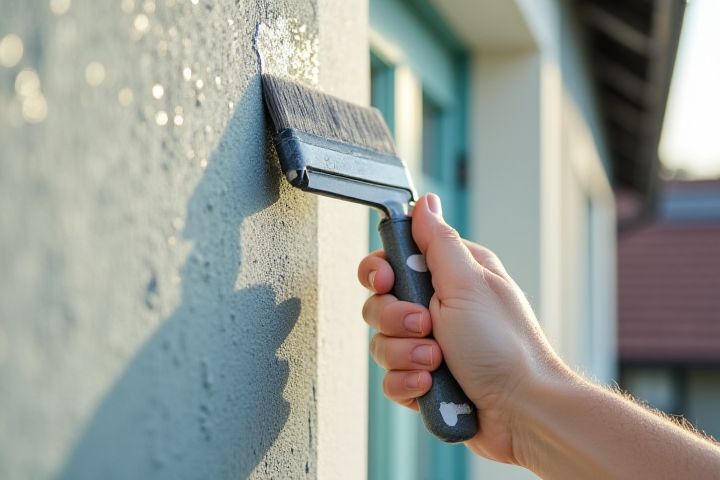
The ideal time to paint the outside of a house is during mild weather conditions, typically in late spring or early fall. Temperatures should ideally range between 50degF and 85degF for optimal paint adhesion and drying. It's crucial to avoid painting when rain is forecasted in the short term, as moisture can compromise the paint's durability. Prior to starting, ensure that surfaces are clean and dry, which enhances paint longevity. Regular maintenance, including periodic inspections and touch-ups, can extend the time between major painting projects.
When To Paint The Outside Of A House
Weather conditions
The best time to paint the exterior of your house is during mild weather conditions, ideally when temperatures range between 50degF and 85degF (10degC to 29degC). Low humidity levels, ideally under 70%, help the paint adhere properly and dry quickly, reducing the risk of mildew and fading. Avoid painting during rain or extreme heat; temperatures above 90degF (32degC) can cause paint to dry too fast, leading to poor adhesion and an uneven finish. Monitor the weather forecast for at least 24 hours after painting to ensure no rain or drastic temperature changes that could affect your newly painted surface.
Temperature ranges
The ideal temperature range for exterior house painting is between 50degF and 85degF (10degC to 29degC) for most paints. Avoid painting on days when the temperature exceeds 90degF (32degC) or drops below 50degF (10degC) to ensure proper adhesion and drying. High humidity levels above 80% can also adversely affect paint application, leading to peeling or bubbling. To achieve a long-lasting finish, plan your painting project during the spring or fall when temperatures are more stable and conducive to painting conditions.
Humidity levels
Humidity levels play a crucial role in determining the optimal time to paint the exterior of a house. Ideally, paint should be applied when relative humidity is below 70%, as higher humidity can cause poor adhesion and slow drying times. The best conditions occur during late spring or early fall, when temperatures range between 50degF to 85degF, and humidity levels are typically lower. Monitoring local weather forecasts can help ensure that you select a suitable day for your painting project, promoting long-lasting results.
Paint type
Choosing the right paint type for your house's exterior is crucial for durability and aesthetics. Acrylic latex paint is often recommended due to its flexibility and resistance to fading, making it ideal for varying weather conditions. In contrast, oil-based paints are known for their richness and gloss but require more maintenance over time. Always consider local climate factors; for example, areas with high humidity may necessitate mold-resistant formulations for optimal protection.
Prep work required
Preparing to paint the exterior of your house involves several crucial steps to ensure a long-lasting finish. Begin by cleaning the surfaces with a power washer, removing dirt, mildew, and peeling paint; aim for at least 24 hours of dry conditions afterward. Scraping and sanding any rough areas will help the new paint adhere better, while repairing cracks or damage in the facade is essential for a smooth application. Finally, applying a high-quality primer suited for your surface can enhance color richness and increase paint durability, making it an important prep step to consider.
Surface condition
Painting the exterior of your house should typically occur when the surface condition indicates significant wear and tear. Signs such as peeling, cracking, or flaking paint suggest that it's time to repaint, which can occur approximately every 5 to 10 years depending on climate and materials. A thorough inspection for mildew or mold is essential, as these can affect both appearance and structural integrity. Ensuring the surface is clean, dry, and free from imperfections not only enhances the aesthetic but also prolongs the life of your new paint job.
Longevity goals
Painting the exterior of your house is best timed for late spring or early fall, when temperatures range between 50degF and 85degF (10degC - 29degC). These temperatures promote optimal adhesion and drying, ensuring a durable finish that can last 5 to 10 years depending on your chosen paint quality. Higher humidity levels and extreme weather conditions can compromise the longevity of the paint, potentially leading to peeling or fading within a couple of years. Consider scheduling your painting project every 5 years to maintain your home's aesthetic appeal and protect against environmental wear and tear.
Local regulations
Before painting the exterior of your house, it's essential to check local regulations, as they can vary significantly by community. Some municipalities may require permits, especially if you're in a historic district or if you plan to use specific colors. Local homeowners associations (HOAs) might also have rules regarding color schemes and aesthetic guidelines. Ensure that you comply with these regulations to avoid potential fines or mandated repainting.
Surrounding environment
The ideal time to paint the outside of a house is during moderate temperatures, typically between 50degF and 85degF, to ensure optimal drying and adhesion. Consider the surrounding environment; for instance, avoid painting during rainy seasons, as moisture can lead to paint failure or slow drying times. If your home is near pollen-producing plants, painting in late afternoon or early evening can minimize the amount of debris settling on wet paint. You should also be mindful of local humidity levels, aiming for a humidity level below 70% for the best results.
Seasonal patterns
The best time to paint the exterior of your house typically falls in late spring or early fall, when temperatures range between 50degF and 85degF, as this ensures optimal adhesion and drying. During these seasons, humidity levels are generally lower, reducing the risk of paint trapping moisture and ultimately leading to blistering. Avoid painting during high heat or direct sunlight, as it can cause the paint to dry too quickly and may result in an uneven finish. Monitoring weather forecasts for at least two consecutive dry days will also help ensure successful painting without interruptions from rain.
